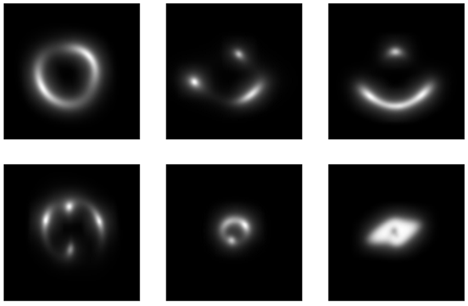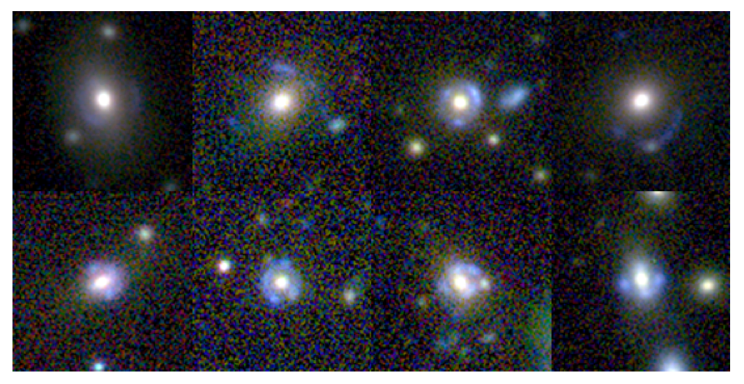Discovering gravitational lenses with Artificial Intelligence
Mass bends light, as predicted by Einstein’s General Relativity. This process is the well-known Gravitational Lensing. When a galaxy (named source in the lensing formalism) is behind another galaxy (i.e., the lens), we can sometimes see the hidden one to appear around the lens, as multiple images, arcs or a ring. When source and lens are aligned along the line of sight, then the so-called Einstein ring forms. A gravitational lens is a wonderful and very rare astrophysical event, but also a powerful probe of lens and source properties. It can provide the most precise mass estimate in Astrophysics, the mass of the lens galaxy within the radius of the Einstein ring! This is the reason why many groups of astronomers are searching for new samples of strong gravitational lenses.
However, this hunt is troublesome, since astronomers have to sort hundreds of thousands of images using the eye. This effort can be prohibitive thinking to the vast amount of data coming from present and future wide-sky surveys, which will observe large portions of the sky, injecting terabytes of data in the computers of astronomers. To tackle this growing amount of data, the astronomers are using the Artificial Intelligence, in particular, the so-called "convolutional neural networks", which have been already employed by, e.g., Google and Facebook. Specifically, Facebook is using a code of Face Recognition, to pick up the faces in the uploaded pictures.
An international group of astronomers employed such convolutional neural network to search gravitational lenses in the Kilo Degree Survey (KiDS), a wide sky survey conducted on the VLT Survey Telescope (VST), a 2.6-meter ESO telescope located in Chile and designed by astronomers of the Capodimonte Astronomical Observatory in Naples. These results are published in the article [1] ‘LinKS: Discovering galaxy-scale strong lenses in the Kilo-Degree Survey using Convolutional Neural Networks’ led by Carlo Enrico Petrillo, PhD at the Kapteyn Institute in Groningen (The Netherlands) and Crescenzo Tortora, second author of the paper, and Post-doc at the Arcetri Astrophysical Observatory. This paper uses the results of two previous papers [2,3], written by the same authors, and collect hundreds of lens candidates (mostly newly discovered) using the fourth data release of KiDS.
 |
| Figure 1: Simulated arcs, which will be located on the top of real luminous red galaxies in KiDS images, to create the mock gravitational lenses used to train the network. |
The astronomers trained two different neural networks (one is purely morphological and the other exploits color information in addition to morphological information) using millions of homemade images of mock gravitational lenses, created by simulating arcs and rings around real KiDS red and massive galaxies (see Figure 1). Then, they applied the “trained” network to the images of 88,000 red luminous galaxies, extracted from 900 sq. deg (KiDS-DR4). The network decides what is a lens and what is not a lens, and the result of this automatic classification is a list of 3500 lens candidates. These targets are visually inspected by the astronomers, reducing the sample to 1983 rank-ordered targets, which are classified as potential lens candidates (see some examples in Figure 2). This sample, dubbed LinKS ("Lenses in KiDS"), is provided to the astronomical community for follow-ups and further analysis.
 |
| Figure 2: Eight example lenses found by the convolutional neural network in Petrillo et al. [1]. |
To validate these bone fide systems, the team has started a spectroscopic follow-up at the SALT telescope in South Africa. The project is led by Lucia Marchetti (Cape Town, South Africa), Crescenzo Tortora (OA-Arcetri) and Chiara Spiniello (Napoli, Italy) and aims at performing the spectral validation of the gravitational lenses discovered in KiDS and in other independent surveys. In particular, the first preliminary results of this follow-up are shown in Spiniello et al. [4], which describes the validation of two quadruple lensed quasars from DES, which are extremely rare systems among gravitational lenses.
Upcoming facilities (as LSST and Euclid) will observe large areas of the sky with unprecedented quality, providing the perfect conditions to apply Artificial Intelligence to search for many and new gravitational lenses. This will provide a detailed view of the mass profile, the dark matter fraction and the dark matter substructure in massive galaxies across a wide range of environments and of redshift, getting information about physical processes which shape their mass assembly.
References:
[1] Petrillo et al. 2019, ‘LinKS: Discovering galaxy-scale strong lenses in the Kilo-Degree Survey using Convolutional Neural Networks’, accepted for publication in MNRAS (also available at arXiv:1812.03168)
[2] Petrillo et al. 2019, ‘Testing convolutional neural networks for finding strong gravitational lenses in KiDS’, MNRAS, 482, 807
[3] Petrillo et al. 2017, ‘Finding strong gravitational lenses in the Kilo Degree Survey with Convolutional Neural Networks’, MNRAS, 472, 1129
[4] Spiniello et al. 2019, ‘Spectroscopic confirmation and modelling of two lensed quadruple quasars in the Dark Energy Survey public footprint’, (also available at arXiv:1901.04414)
To read further (in Italian) see: Lenti gravitazionali con l'intelligenza artificiale
Edited by C. Tortora and A. Gallazzi



